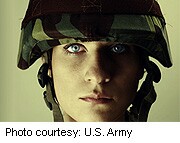- Double Mastectomy May Offer No Survival Benefit to Women With Breast Cancer
- Toxic Lead Found in Cinnamon Product, FDA Says
- Certain Abbott Blood Sugar Monitors May Give Incorrect Readings
- Athletes Can Expect High Ozone, Pollen Counts for Paris Olympics
- Fake Oxycontin Pills Widespread and Potentially Deadly: Report
- Shingles Vaccine Could Lower Dementia Risk
- Your Odds for Accidental Gun Death Rise Greatly in Certain States
- Kids From Poorer Families Less Likely to Survive Cancer
- Tough Workouts Won’t Trigger Cardiac Arrest in Folks With Long QT Syndrome
- At-Home Colon Cancer Test Can Save Lives
Women Vets May Need More Access to Breast Cancer Services


FRIDAY, Sept. 20Women are the fastest-growing segment of the U.S. veteran population, making breast cancer screening a crucial public health issue for the Veterans Health Administration (VHA).
As the agency has worked to expand mammogram screening, the need for other diagnostic tests and treatments has also grown, and a new study that looked at how well women’s follow-up needs have been met suggests that more resources are likely required.
From 2003 to 2009, the use of VHA outpatient care nationwide by women grew by 47 percent, and demand is expected to increase even more as thousands of women veterans return from Iraq and Afghanistan.
To accommodate these changing needs, the VHA made the Women’s Health Program a priority in 2007, including a recommendation to improve access to screening mammography and related breast cancer care services.
The Baltimore VA Medical Center, which accelerated its breast cancer screening program in 2008, now reports on their effort to do so, hoping to serve as a model for other VA Medical Centers.
“We have successfully expanded screening mammography services,” said Dr. Ajay Jain, chief of surgical oncology at the Baltimore VA and an assistant professor of surgery at the University of Maryland School of Medicine, in Baltimore. The report is published online Sept. 18 in JAMA Surgery.
While the center has screened more women since the program expansion, the increased access did lead to extending time from diagnosis to treatment and increased use of non-VA facilities for follow-up of mammography results, due to lack of staff onsite, Jain reported.
Jain’s team compared care before and after the 2008 expansion. The researchers looked at the number of mammograms in both periods, trying to determine if the program changes would increase patient volumes, decrease time it would take to get treatment if needed and increase the rate of breast-conserving treatment compared to mastectomy.
From 2000 to 2012, a total 7,355 mammograms were done, with the bulk, 6,720, done after the program expansion in 2008. Even though the Baltimore VA had added staff and test equipment, more than 86 percent of the women had to get care using not only the Baltimore VA but also other institutions.
From 2000 to 2012, 76 women received breast cancer treatment. The time from diagnosis to the start of treatment increased from 33 days before the expansion to 51 days afterwards. While more than 67 percent of women eligible for breast-conserving treatment received it, nearly 33 percent had a mastectomy.
“If you are going to expand screening mammography, you should expect to see more breast cancer,” Jain said. His facility will continue to add staff and equipment. Developing a breast care program totally on site is more cost-effective, he said, and the comprehensive care in one place is preferred by women.
“We are one of the few [VA medical centers] at the leading edge of the curve here,” he said. A few other of the more than 1,800 VA facilities nationwide are at work expanding breast care services in a similar way, he said.
The program expansion is a step in the right direction, said Dr. Julie Gralow, a professor of medical oncology at the University of Washington School of Medicine and director of breast medical oncology at the Seattle Cancer Care Alliance.
“It is important to create awareness and institute active screening programs for breast cancer, but this paper points out that this needs to go hand-in-hand with increasing access to diagnosis once something abnormal is identified, as well as access to treatment,” said Gralow.
The finding of an extended time-to-treatment shows that the VA ”clearly overwhelmed its internal capacity for diagnosis and treatment of breast cancer with the success of its screening program,” she said.
“The message for military women, and all women, is that we need to advocate for ourselves regarding our health,” she said. A diagnosis of breast cancer, she said, is rarely an emergency needing immediate treatment. However, she added, ”getting rapid access to information and support can have a major impact on the anxiety and fear that frequently accompany a breast abnormality or breast cancer diagnosis.”
More information
To learn more about VA’s Women Health Services, visit the U.S. Department of Veterans Affairs.
Source: HealthDay
Copyright © 2024 HealthDay. All rights reserved.










